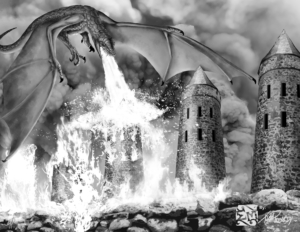
Dragon Fire
From H’Ilgraith, Sister of the House of H’Aleth
Illustration by Epic Made
Sabotage
The scouts completed transforming once again into [a pack of] wolves for the trip back to H’Aleth. They had just left the outcropping when they heard a deep rumble and the sound of rocks loosening. It sounded like an earthquake; yet the ground was not heaving, and no cracks were opening up. Suddenly, a gale force wind blew across the area. A great gray dragon had arrived.
The scouts watched as the dragon spewed his searing fire across the entire section of the canal. It melted the mortar holding any stones in place. The rocks lining the canal gave way and fell into the bottom of it. Finally, the heat of his fire fused together any stones that had collapsed in a heap, littering the bottom of the canal. The entire structure was in ruins.
As the pack watched the dragon, they were mesmerized. His firepower was breathtaking.
(Excerpt from H’Ilgraith, Sister of the House of H’Aleth.)
Introduction
Most stories of fire dragons speak of dragons as “breathing fire”. If this were literally the case, the dragons would die from self-immolation. Their own fire would set their chest ablaze. Since the chest cavity contains the heart and lungs, setting it on fire would be lethal. The flames would spread rapidly throughout the rest of the body and, finally, engulf it entirely. Thus, in a science fantasy novel, the notion of dragons breathing fire needs to be dispelled.
The Science Underlying Dragon Fire
When the child asked how dragons breathe fire, the old woman replied, “They don’t. They generate their fire from glands in their throat.” (Excerpt from Homo transformans: The Origin and Nature of the Species.)
Mammals have salivary glands that produce a liquid (saliva) which keeps the oral cavity moist, aids in chewing food, provides enzymes (e.g., amylase) to initiate the process of digestion, and contains many antimicrobial agents (Dawes, et al., 2015; Hosoi, 2016; Pederson, et al., 2018; Proctor, 2016). Saliva is 95% – 99% water. It also contains volatile organic compounds including ethanol, methane, and dimethyl disulfide (Leopold, et al., 2014; Milanowski, et al., 2017; National Center for Biotechnology Information). Most of the volatile compounds are byproducts of metabolism (methane, dimethyl disulfide) and fermentation (ethanol). Methane is a flammable gas. Ethanol and dimethyl disulfide are flammable liquids. When mixed with air (for methane) and water (for methyl disulfide), these agents are explosive and provide a source of intense heat.
In the novel Homo transformans, dragons also have an (imaginary) incendiary gland paired with a salivary gland on each side of the throat. The incendiary gland contains a mixture of carbon and hydrogen (a hydrocarbon), a mixture of sulfur and oxygen (sulfur trioxide), and nitrogen ‒ all natural compounds. Hydrocarbons are highly flammable. Sulfur trioxide is not flammable; however, it supports combustion and reacts explosively when mixed with water. The paired incendiary and salivary glands are co-located and adjacent to each other. The mixture from their combined secretions are the source of the dragon’s fire.
Dragon Fire
To generate fire, one needs fuel, oxygen, and a source of heat. The constituents of the salivary glands and the (imaginary) incendiary glands provide sources of fuel which are readily available. When both glands contract simultaneously and expel their contents, the sulfur trioxide and volatile acids react explosively with water in the saliva to release heat. Oxygen (in exhaled and ambient air) supports combustion of the hydrocarbons.
The dragon is already breathing out (exhaling) forcefully when this reaction takes place. The air pressure behind a forceful exhalation triggers both the salivary and incendiary glands to release their respective constituents. They begin to mix in ambient air as the pressure wave propels them forward, away from the dragon.
Dragon fire can be sustained for as long as the dragon exhales or for as long as the supply of ingredients holds out. Most of the components of both the salivary and the incendiary glands require substances that must be produced by these glands via some physiologic mechanism. Thus, the supply of these mixtures can be exhausted faster than they can be replaced.
On Deadly Ground
Ruwena [as a red dragon] had used her fire to counter the onslaught by Cassius’s creatures. Although she had destroyed the forces sent against the villagers, it was not enough. Cassius sent forth even more of his creatures as pawns. He could afford it. He need only wait until the dragon’s supply of fire was depleted … and it was. Although Ruwena’s attack was successful, it had taken all of her remaining fire to do so. There would be no more until a sufficient quantity of its constituents could be produced by the glands that supplied it. (Excerpt from Homo transformans: The Origin and Nature of the Species.)
References
Dawes, C., Pedersen, A.M., Villa, A., et al. (2015.) The functions of human saliva: A review sponsored by the World Workshop on Oral Medicine VI. Arch Oral Biol, 60(6), 863-74. doi: 10.1016/j.archoralbio.2015.03.004.
Hosoi K. (2016.) Physiological role of aquaporin 5 in salivary glands. Pflugers Arch, 468(4), 519-39. doi: 10.1007/s00424-015-1749-6.
Leopold, J. H., van Hooijdonk, R. T., Sterk, P. J., et al. (2014.) Glucose prediction by analysis of exhaled metabolites – a systematic review. BMC Anesthesiol, 14:46. doi: 10.1186/1471-2253-14-46.
Milanowski, .M, Pomastowski, P., Ligor, T., Buszewski, B. (2017.) Saliva – Volatile Biomarkers and Profiles. Crit Rev Anal Chem, 47(3), 251-266. doi: 10.1080/10408347.2016.1266925.
National Center for Biotechnology Information. PubChem Database. Dimethyl disulfide, CID=12232, https://pubchem.ncbi.nlm.nih.gov/compound/Dimethyl-disulfide (accessed on Aug. 17, 2019).
Pedersen, A. M. L., Sørensen, C. E., Proctor, G. B., et al. (2018.) Salivary secretion in health and disease. J Oral Rehabil, 45(9), 730-746. doi: 10.1111/joor.12664.
Proctor, G. B. (2016.) The physiology of salivary secretion. Periodontol 2000, 70(1), 11-25. doi: 10.1111/prd.12116.